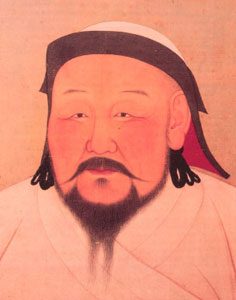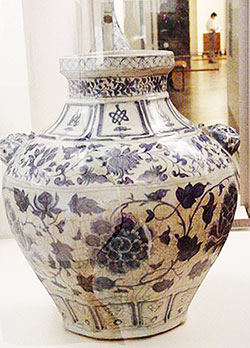
Kublai Khan of the Yuan Dynasty
Who were the Mongols?
In 1276 AD, when the Mongols invaded and took over China, they had already been ruling a large empire for about fifty years. Their empire stretched from India and Russia to northern China and Korea.
Genghis Khan and the Mongols
More about Korea
All our China articles
The Mongols invade China
In 1276 the Mongols captured the Song capital at Hangzhou, and by 1279 the Mongols controlled all of China and Korea. Kublai Khan, the Mongol leader, moved the capital of the Mongol empire from Karakorum in Central Asia to Beijing, China. In 1271, when he was 56, Kublai Khan declared himself emperor of China. His daughter married a Korean prince.
The end of the Song dynasty
 Kublai Khan rules China
Kublai Khan rules China
Kublai Khan tried to conquer Japan in 1274 and 1281 AD, but was prevented by a great storm. He also tried to recapture northern Vietnam (Annam) and Burma, but without much success. Even in China and Korea, Kublai Khan was not very popular. The Chinese were very angry that Kublai Khan gave foreigners (mostly Muslims from Central Asia) all the jobs as governors and judges, instead of choosing Chinese people.
Islam in China
Vietnam’s history
Kamakura Japan
After Kublai Khan
Kublai Khan died in 1294 AD. Kublai Khan’s descendants kept on marrying Korean rulers, and not Chinese people. But Kublai Khan did not trust the people of China. And the Chinese were also angry that the Mongols kept their own language and customs, and didn’t want to act like the Chinese.
Cotton clothing in China
On the other hand, the Yuan Dynasty emperors did promote a lot of trade over the Silk Road, and China became richer as a result. The Mongols also used tax policy to promote growing cotton for clothing, and under the Yuan Dynasty most Chinese people switched from wearing hemp clothing to wearing cotton, which was cheaper and cooler in the summer.

A person with a bubo from bubonic plague on their leg
The Black Death in China
By the 1330s, people all over the whole Mongol Empire were suffering from the Black Death – the bubonic plague. Millions of people died in China. The plague made it hard to keep the empire together.
Symptoms of the Black Death
The Red Turbans’ revolt
During the 1350s AD, a revolutionary movement called the Red Turbans became active in northern China. In 1356, the Red Turbans, under the leadership of Chu Yuan-chang, captured Nanjing. Chu Yuan-chang gradually conquered China, and threw out the Mongols, then being ruled by Empress Ki. In 1368 AD Chu Yuan-chang declared himself emperor of China, under the name Hung-wu, and then he finally captured the Mongol capital at Beijing, starting the Ming Dynasty.
Learn by doing: watch the movie of Mulan, where the Chinese are fighting off the Mongols
Go on to Ming Dynasty China
Bibliography and further reading about Chinese history:
Eyewitness: Ancient China, by Arthur Cotterell, Alan Hills, and Geoff Brightling (2000). .
China (History of Nations), by Greenhaven Press (2002). For teens. The negative review on Amazon is actually for a different book – don’t be alarmed!
The Mongol Empire, by Mary Hull (1998). For teens.
Khubilai Khan: His Life and Times, by Morris Rossabi (1990). A biography for adults, sticking closely to historical sources.